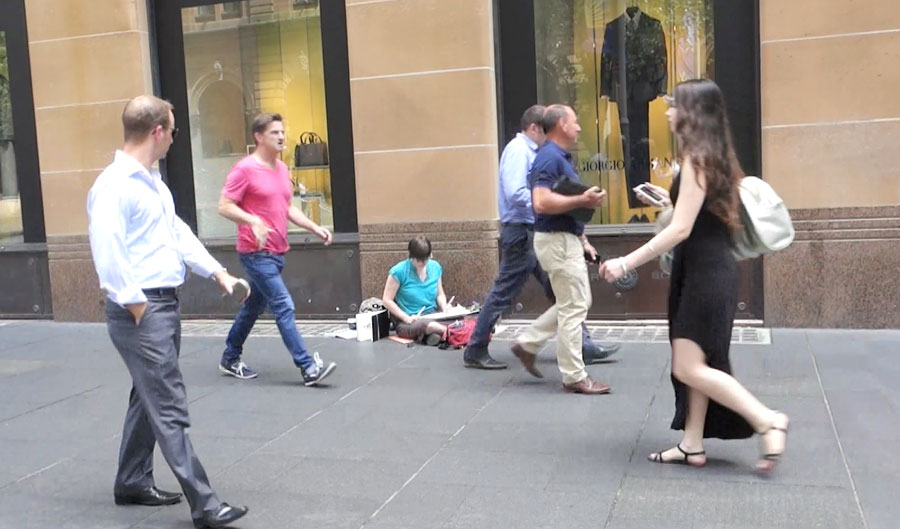
Continuing on with my series of reflections from my first online class SketchingNow Foundations, today I want to review the final part of the course…. when we headed out on the street, to sketch on location – to do some Urban Sketching.
Part 1: Sharing the Framework
Part 2: Beginning the Sketch. Setup and Balancing Line and Colour
I meet many people (both in real life and virtually) who really want to do some Urban Sketching but feel overwhelmed when they try to sketch outside. Being able to join a local sketching group does help a lot, but not everyone has a group nearby and even if you do, beginners can sometimes be a little discouraged by how easy it looks for the ‘seasoned sketchers’. It is therefore very important to have a few strategies in place.
The first is to have a healthy attitude to exposing our marks on the page in a public place. It is possible that we will be able to sketch without anyone noticing us but chances are that sooner or later (sooner rather than later) someone will come up to see what we are doing. We have to overcome this fear – I know it IS a real fear as I have experienced it and even now some days I don’t feel like making a spectacle of myself!
But it gets so much easier the more you do it – it really does – trust me! Ultimately it is extremely rare that you will get a negative comment. There is no requirement to be an award winning artist before attempting to sketching outside (!!!) and absolutely no shame in admitting you are a beginner sketcher – most people will say ‘ you are so talented’ regardless of how much of a disaster you think your sketch is. Tell them what you are doing, what skills you are developing and they will be full of admiration. And oh by the way, you normally get people looking over your shoulder when you feel the most out of control! But they do not know you are not confident unless you tell them – they will just assume that you are – so embrace this …and just go for it.
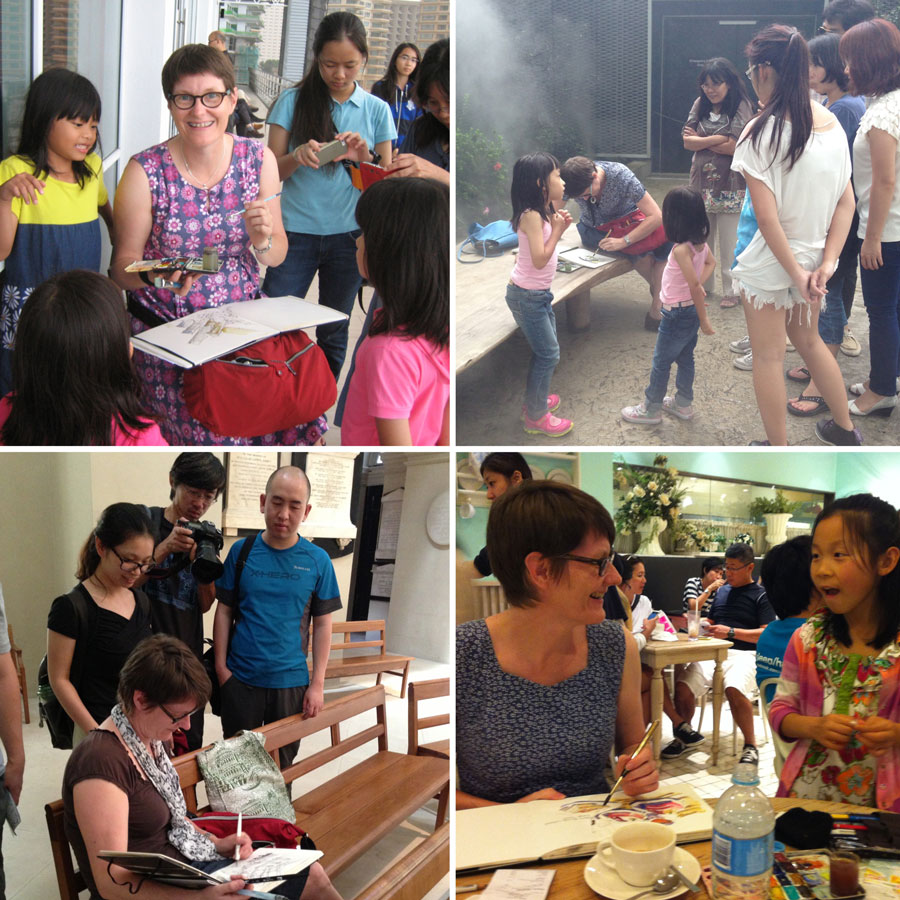
And you know what? – you might become like me – you might become addicted to this interaction! I love that sketching is connecting me in a real way with the people around me. Meeting children is just the best!
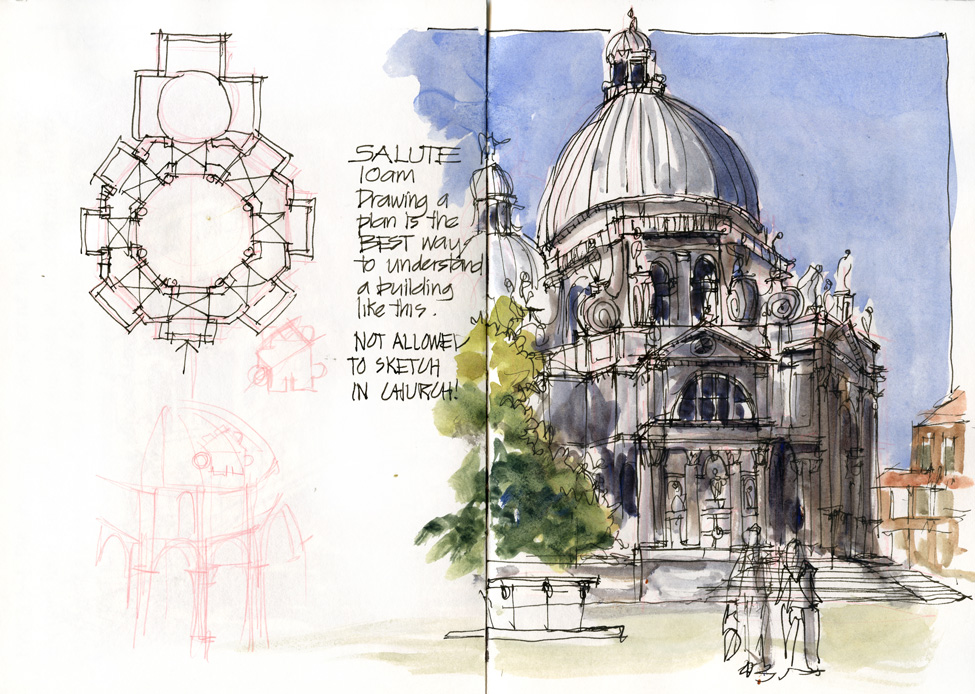
We have to also be prepared for interruptions and imperfect, unfinished sketches. I was very frustrated that we were thrown out of sketching inside the Salute, but this has become my most published sketch!
So when we head outside….
The starting point is to ask ourselves what interests us the most about a scene – what is our story? Often we just start to sketch and try to include everything but by spending a little time having a conversation with ourselves we can focus in and make our sketch simpler and stronger.
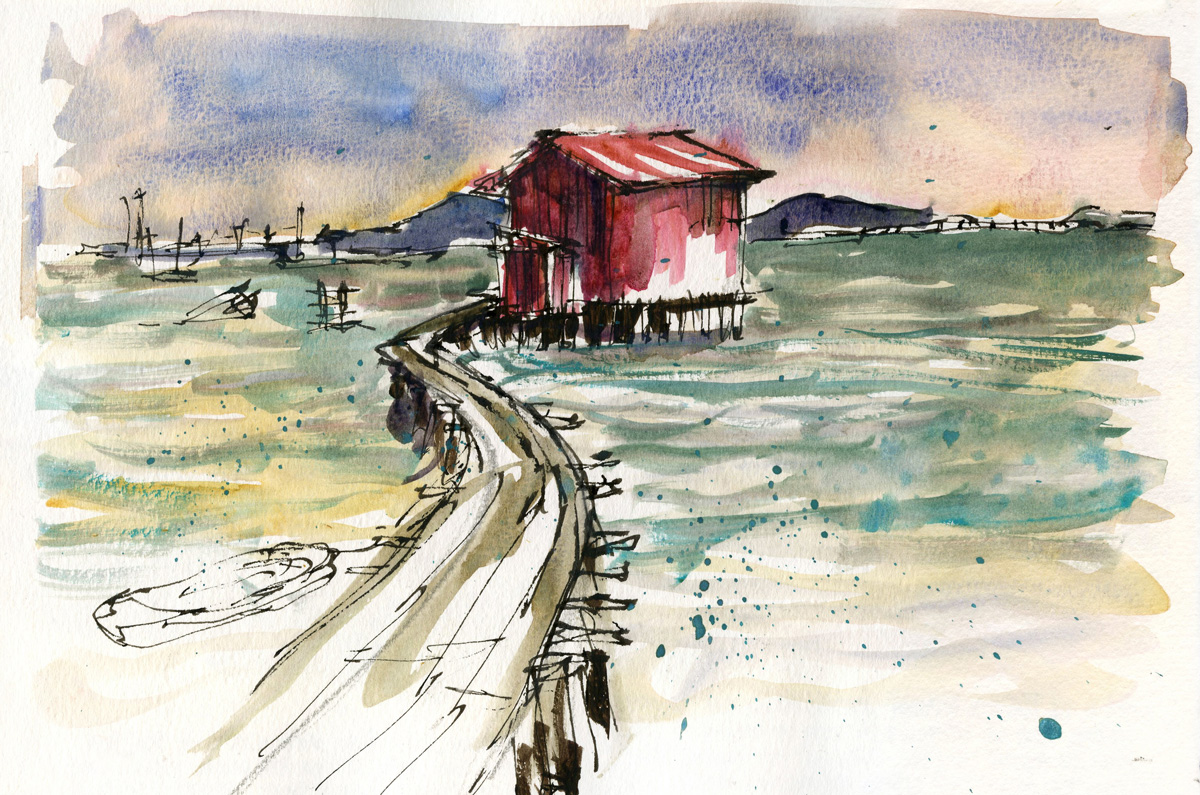
In the Foundations course we looked at the best way to frame (size and orientation) and then compose this story (using the rule of thirds), and then how to set out the major edges and simplify the shapes.
We looked at these steps using three different approaches:
– using a viewfinder, which is a good tool to help us abstract the scene into edges and shapes but is hard to use out on location
– using thumbnail sketches to explore the story and strengthen the composition
– working more spontaneously from our focus outward
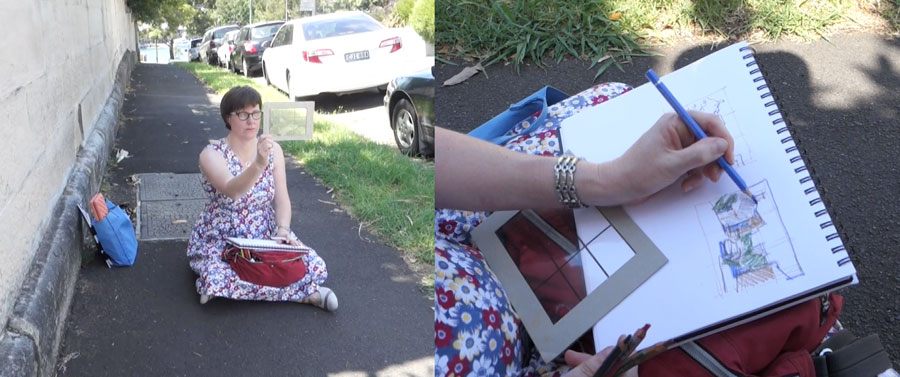
I never use a viewfinder for my own sketching on location but it is a very useful tool. Rather than a credit card size frame, I find a larger A5 size viewfinder with a grid of thirds far more practical for urban sketching. I use it not only to frame and compose the scene but also to set out the major edges.
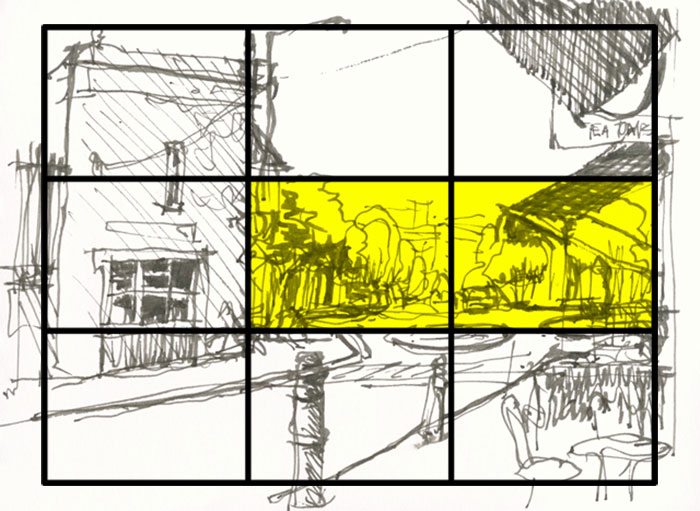
Like the setup lessons, I really benefited from preparing the lessons using a viewfinder. It has made me appreciate more clearly how much objects foreshorten and how we have the tendency to draw things in the middle ground and background too big. I am now much more conscious of sizes in the middle zone – here is an overlay of one of my sketches from Five Ways Paddington showing this area.
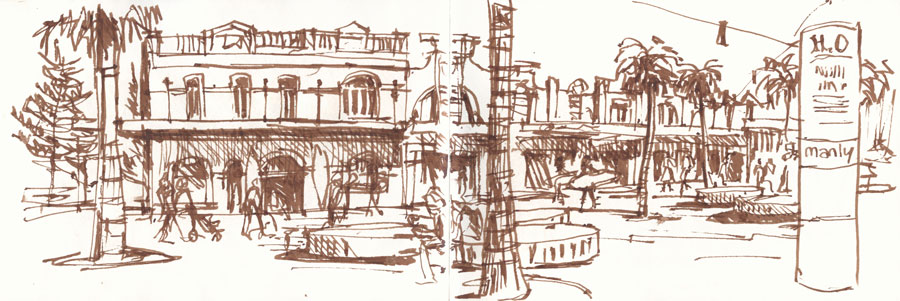
My recent drawings have certainly benefited greatly from the somewhat painful exercise of using a viewfinder. I mean, the viewfinder is a pain – it moves every time you look down, your arm gets tired holding it up and is somewhat tedious to align the edges in the same spot each time – it really does take the spontaneity away! I also find it unnatural to frame the view – when I sketch I want to draw larger than what I can fit into a rectangular frame, such as this recent sketch of The Corso in Manly — that would never fit into a viewfinder frame! But every now and again, an exercise like this does your observational skills a lot of good!

Drawing thumbnails is another technique that I rarely do. I often do them ‘mentally’ or draw one mid sketch when I feel like I am losing my way. However, the day that my thumbnail demo was filmed something very special happened! We went to the Reservoir Gardens in Paddington and my intention was to do a few thumbnails to explore different ways of drawing the scene in front of me. I started an incredible journey of discovery – as I was during one thumbnail, my eye discovered another element that could tell a different story and I ended up with a double-page spread of 10 completely different compositions and stories. And it was all recorded on video – which was very exciting.
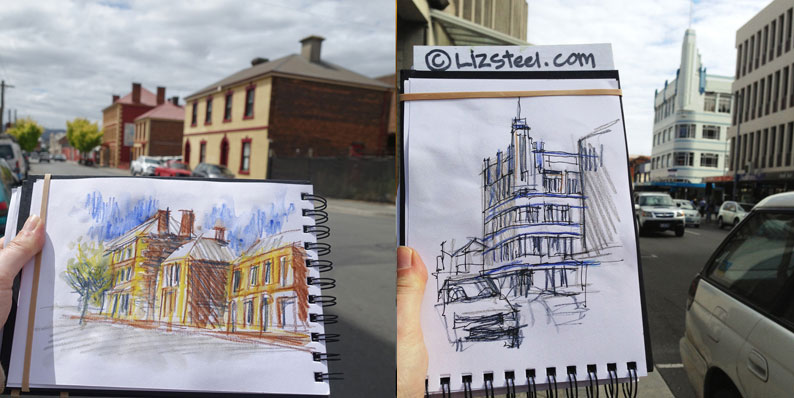
This experience has really made me appreciate how satisfying it is to draw small exploratory sketches – which ties in with some of the recent ideas that have been kicking around in my head (post Brazil symposium). It also made me realise that often I don’t attempt a sketch because I have in mind that I must do a serious work of art. Maybe I could do a series of thumbnails to explain a place rather than a full painting? When I was in Tasmania I was thinking about doing ‘thumbnail sketches’ but they ended up being full size due to the small sketchbook I was using…but it was liberating to think of doing more quick studies rather than finished work.
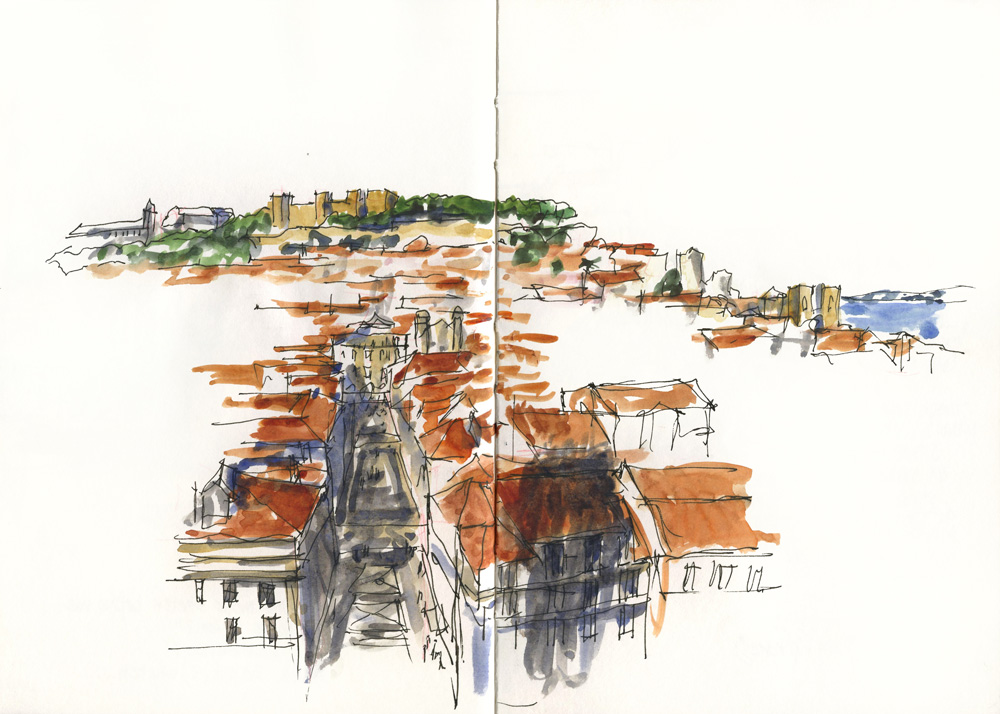
The final approach, working out from a focus, IS the way I mainly work… starting at the point that interests me and working in a spontaneous way out from that point as I have time or inclination – such as this sketch of a classic view of Lisbon where due to time restrictions I only drew the main features. I think this way of working is one of the key differences between sketching and traditional painting or drawing.
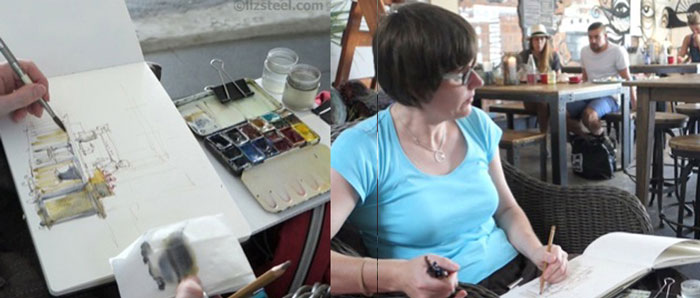
I choose a cafe as the location for this lesson’s demonstration and ended up doing a more complex scene than I had intended (getting staff approval for filming can mean sitting in a corner out of the way!) and it turned out to be a good example of how your focus can sometimes change while you are working! But hey, I love the risk-taking and the spontaneous evolution of your work while you are sketching on location…and I feel that this particular lesson was the icing on the cake.
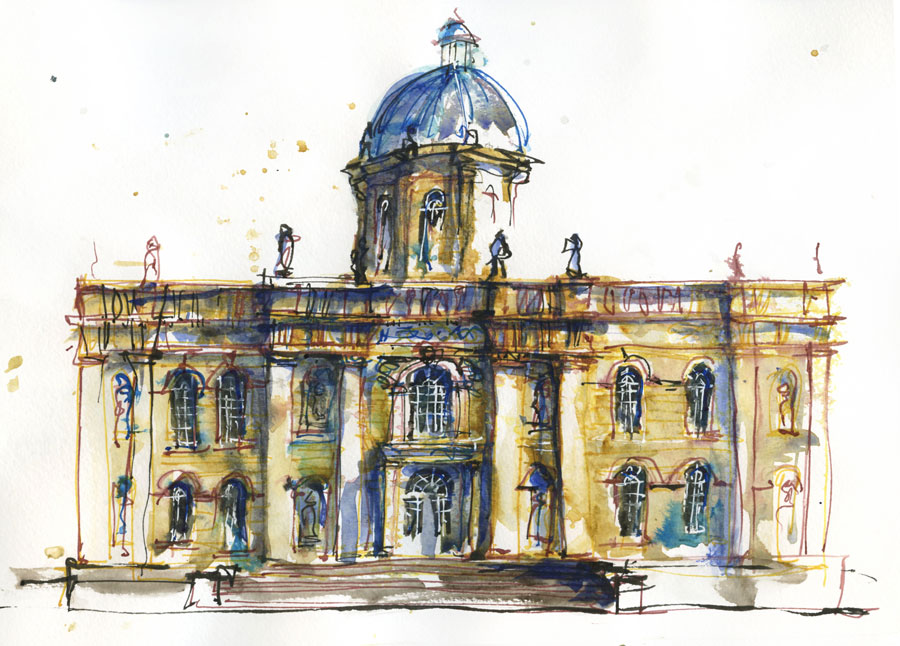
Of all the variations of Castle Howard I did the other week, Version C where I just started in the middle, was the one I enjoyed most. There is a special life expressed by my marks when I work this way – starting without any idea of what the end result will be.
There is no doubt that these three lessons dedicated to sketching on location were the really exciting part of the Foundations course for me – filming out on location was super fun but also added more complexity to the experience. I am determined to do more of these location demos in future courses!
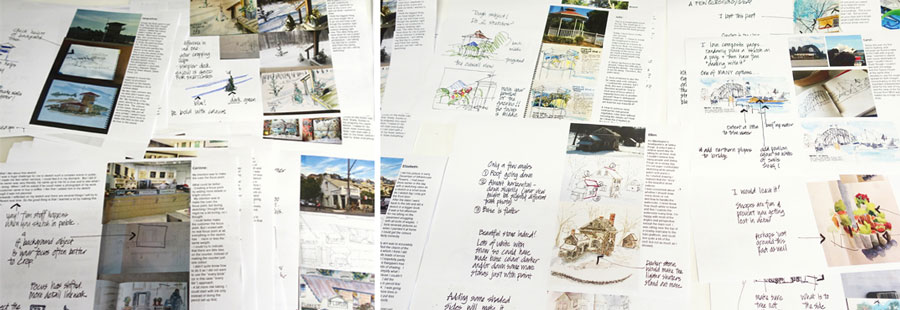
The Final Lesson…..
And the final week was the cherry on top of the icing! I reviewed 30 people’s work, doing thumbnails markups and scribbling comments of their work. Doing this enabled me to connect all the ideas we had looked at over the 12 weeks, and it was great to group them together into themes.
Putting together the Foundations course was the most incredible experience, and there are no words to describe how amazing it was to have people from all over the world doing the exercises and sharing their work. I often got tears in my eyes when I was reviewing the work done each week (and particularly reading the descriptions of the process). I often felt like I was looking over their shoulders. I can’t wait to re-offer Foundations and offer a new course… but there is a lot of back of housework to do first and there all the content for the next course to prepare – there is no way that I am going to put all the content together during the course (that was insane to think I could that easily)
It has been great to do these review posts and reflect on how much I personally got out of putting together and sharing the content… how much it has helped my own work and how powerful I believe it is to re-visit the core concepts often! We never get past sharpening our observational skills.
So finally – a huge thank you to every single person that enrolled in my Foundations Course. It was bigger and better in every respect that I ever imagined it could be. Thank you for being part of that… and look forward to SketchingNow again with you soon!
This is the third part of a series of posts reviewing my SketchingNow Foundations Online Course: The other articles in the series are here
Part 1: Sharing the framework
Part 2: Beginning the Sketch and Balancing Line and Colour
Subscribe to my mailing list for my monthly newsletters including first notification of my new SketchingNow Online Sketching Courses and face-to-face workshops.




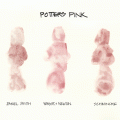
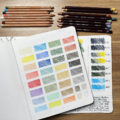
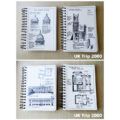
17 Comments
thanks Susan – setting out major edges is something that we look at in the Foundations course… I am just giving my blog readers a overview of the content!
haven't got a date yet – a bit of work to set it up again but am working on it!. I hope it will not be too long away!
Hi Denitsa – yes I am working on that!
thanks rene – yes I think most of us used to be a lot less confident to sketch in visible places. USK has really helped my confidence in this regard!
Now i also want to try out a Viewfinder for my next trys…
Do you have some idea when you will start the next Foundation Course? 😉
Please offer the Foundations course again, at least as a self study! ??
Love this review, I had the same experience. In the early days I never dared to draw on streets, mostly did it from hidden places or behind windows. Nowadays I go out and just do it in plain view. Sometimes in the middle of a not too crowded street (if you remember the point where you stood, you can always return). Noone so far has ever reacted disapprovingly. But if the observer tells something more than just approval, I only have to look at the sketch and I can recall it years after. The sketchbook becomes littered with stories.
Liz, I'm so enjoying your review of your course experience and seeing all the photos and sketches. I learn bits and pieces from each post. I do have a question from this one: What does it mean to "set out the major edges"? I've never heard that expression.
Yes I know Susan… I was just teasing…though you probably didn't see my smile while I typed that! Oops!
I am not sure if it is a standard art phrase that is googlable… just how I refer to looking for the main components, the major edges and then putting them in place first
Sorry, Liz. I didn't mean to imply I was asking for course content. I just thought there might be a general definition for the phrase, since I'd never heard it before. I'll try Googling it.
Thanks, Liz. 🙂
Really great going through this review process with you and hearing your thoughts. It's also a great aide memoir – I am working my way through all the Foundations lessons again, just before we launch what we hope will be a new USK chapter for the SW UK – we have our first official sketch crawl in a couple of weeks so I am pretty excited! Doing your class really gave me the final push I needed to try and get a group started, so thank you Liz!
Thanks for your review–it is a very helpful summary of the 3 main processes for addressing composition when drawing on location. Yes, the viewfinder is a handy tool–I always carry mine in my kit so that when I get overwhelmed by a view, I can use it to get me started. The foundations course's exercises were great and it was fun being part of the group.
Liz, I SO appreciate your decision to leave active the SketchingNow lessons for a few months. I'm going through them again and taking more time to work more completely through each lesson. I find my sketches have improved and I feel more confident about what I'm doing, more thoughtful about my approach and decisions.
thanks Jules! (sorry for the delay in replying to your comment)
Really great to hear of the formation of SW UK! Yay! keep going!
thanks Carmela – glad you enjoyed the course. Keep going!
So great to hear that you can see improvement and that you are more thoughtful (that is the big key I think). Class will stay up for a long time!
NEWSLETTER
Subscribe for first notification of workshop + online classes and more.